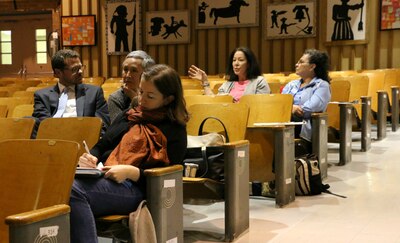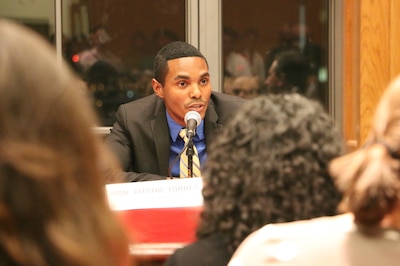Top New York City education department officials are exploring a plan to more evenly spread low-income students and their affluent peers across a Manhattan school district. If approved, experts say it would represent the city’s first district-wide desegregation plan in decades.
Earlier this year, the city launched an initiative that lets individual schools adopt socioeconomic-diversity plans — but officials have yet to sign off on a larger overhaul. However, the education department’s enrollment chief recently met with a consultant who helped develop the proposal for Manhattan’s District 1, which includes about two-dozen schools in the East Village and Lower East Side. The new system could be ready as soon as this fall when parents apply to schools for the 2017-18 school year, according to the consultant, Michael Alves, though that would leave the city relatively little time to prepare families for the change.
Still, officials’ apparent openness to the plan represents a major victory for the local parents and educators who proposed it, and for advocates across the city who have successfully persuaded Mayor Bill de Blasio and his schools chancellor to make integration a priority.
“The administration at first, I think, was hesitant to engage on such a big issue,” said City Councilman Brad Lander of Brooklyn, who has emerged as a leader of the newly energized school integration movement in New York. He said the school-by-school approach showed progress, but that the city must now explore broader plans — such as the one being considered in Manhattan.
“We’ve seen some small steps, but nothing approaching systemic action or even a coherent plan,” he said. “That’s what we want to see from the mayor and the chancellor in the fall.”

Experts consider District 1 a natural place for the city to experiment with a district-wide integration plan.
The district is small, diverse, and already allows families to apply to any school regardless of their address, which is a key component of the proposed enrollment system. Known as “controlled choice,” the plan would still allow families to apply to schools they choose, but it would add information about their income levels and educational background into the matching process. The goal is to reduce the clustering of affluent and needy students in a district where 100 percent of the students at some schools are low income, while just over 20 percent are at others.
Using a state integration grant, local parents and educators partnered with the district superintendent to develop the plan and to hire Alves as a consultant. (He is also working with a Brooklyn district that received a state grant and is exploring a controlled-choice system for its middle schools.)
Alves said that Robert Sanft, chief executive officer of the education department’s enrollment office, recently invited him to a two-hour meeting with his team to discuss District 1. He said he expects to meet next with Josh Wallack, the deputy chancellor overseeing the city’s nascent integration efforts. Alves said the department has not officially signed off on the new enrollment system, but he expects it will.
“I feel very strongly that the administration is committed now to moving forward,” he said, adding, “It’s very significant that Deputy Chancellor Wallack is now engaged in this, [along with] Rob and his staff.”
The current wave of integration advocacy kicked off in 2014 when researchers at the University of California, Los Angeles’ Civil Rights Project declared New York’s schools to be the most segregated in the country. That prompted the City Council to hold a hearing on school segregation, and to pass a bill requiring the education department to release new demographic data and report on any desegregation steps it has taken.
Those efforts were led by Councilman Lander and Bronx City Councilman Ritchie Torres, who also convened several meetings of integration advocates from across the city. In October, that coalition sent a letter to Chancellor Carmen Fariña offering a list of seven recommendations to promote integration.
Since then, the city has taken a few of their suggestions: It launched the initiative in November letting individual schools reserve a portion of their seats for high-needs students — a policy inspired by several principals who had asked for permission to do so nearly a year earlier. It also allowed more high schools to enroll a mix of low and high-performing students by design.
In addition, it has taken some steps that were not listed in the recommendations, but which officials say can lead to more diverse schools. For example, it has added more dual-language programs, which offer lessons in two languages and can appeal to families from a mix of backgrounds. It also started gifted-and-talented programs in several low-income districts that lacked them, and announced a $15 million effort to help more black and Hispanic students gain entry into elite public high schools that use admission exams.
“They’re showing tremendous openness and enthusiasm for this, which is so different from what we saw in 2014,” said David Tipson, executive director of the integration advocacy group New York Appleseed, and a member of the coalition that wrote the letter. “They’ve clearly made a decision to make this a priority and not bury their heads in the sand anymore.”

Still, some in the coalition question whether the recent action reflects a real commitment to integration or simply a response to public pressure.
They point out that the education department has not adopted an official policy affirming its support for integration, nearly two years after the City Council passed a resolution calling on it to do so. (Officials said they have “heard the call” for a diversity policy and are considering it.)
Meanwhile, some of the city’s recent efforts fall short of what the coalition recommended. For instance, the group proposed that the city offer the top students at every middle school a spot at one of the elite “specialized” high schools, which some studies have concluded is the best way to make the schools more diverse. Rather than overhaul the schools’ admissions requirements, as de Blasio promised on the campaign trail, he opted instead to expand programs to help more students pass the entrance exam.
“We think that’s insufficient, to say the very least,” said David Jones, president of the Community Service Society, an anti-poverty organization, which is part of the coalition. “We think there has to be a much more systemic look at this.”
Some advocates also remain deeply skeptical of the administration’s approach to integration, which is centered on building consensus for changes rather than mandating them.
Fariña has said she wants integration to happen “organically,” and has asked principals and superintendents to craft their own plans. And when the education department proposed a rezoning on the Upper West Side last year that would have helped integrate two schools, it retracted the plan after affluent parents rallied against it.
“If changing every heart and mind is the standard for a more integrated school system, then we’ll be like Godot waiting for an outcome that will never come,” said Torres, the Bronx lawmaker, who argued that the de Blasio administration would not have launched its recent integration efforts without the pressure from advocates.
“I suspect the administration sees integration as politically treacherous territory,” he added. “If we leave it to its own devices, there’s going to be no progress.”
Josh Wallack, the deputy chancellor overseeing enrollment, disagreed. He said the education department is focused “first and foremost” on improving the quality of every school, but that Chancellor Fariña is also deeply committed to fostering diverse schools, which she has done both by launching programs and by asking schools and districts to come up with their own ideas.
“The chancellor has been very clear that this is a priority for her,” he said. “During the last year, the focus has sharpened on this even a little bit more.”
The private Oct. 2015 letter from integration advocates to Chancellor Carmen Fariña, which coalition members provided to Chalkbeat:

